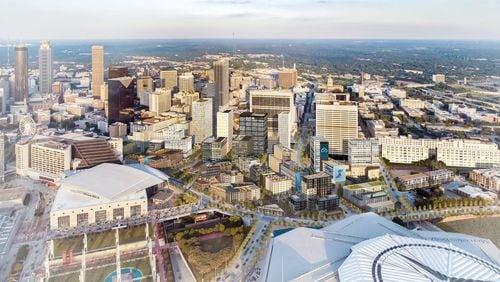It’s a tantalizing prospect — a mega-construction project that would fill in the century-old gap in downtown Atlanta known as the Gulch.
And the project floated by developer CIM Group is also being discussed, separately, as a possible site for a second headquarters for Amazon. Atlanta remains a finalist for that hard-sought development, which could bring as many as 50,000 high-paying jobs here.
The Gulch plan is under consideration by the Atlanta City Council, Fulton County and the Atlanta Public Schools, all of which must approve a deal.
Atlanta Mayor Keisha Lance Bottoms has said in a statement that a Gulch overhaul “will be the largest development of its kind in Atlanta’s history and in the entire Southeast.” That’s a deal size that warrants serious consideration, in our view.
And no one seems to be saying leave the Gulch a patchwork of weeds, parking lots and railroad tracks below the rest of downtown. The sticking point, though, is the pricetag of public money that proponents say is needed as part of the developer’s financing package. The estimated cost of public financing ranges from about $900 million of a $3.5 billion project, up to about $1.75 billion if a full $5 billion buildout takes place.
The public contribution would come through Tax Allocation District (TAD) and state Enterprise Zone dollars raised through property and sales taxes. The public monies would pay for building a “platform” to cover the Gulch and fund other parts of the project. Proponents say that, over time, taxpayers would be made whole — and beyond — via the developer’s bond payments and future tax money from developing land that now generates practically no tax revenue.
In an Atlanta Journal-Constitution news story last month, City Council President Felicia Moore described the plan’s path for government consideration as being on a “very aggressive” timeline. She is correct in asserting that, “The council has every right to know all pieces involved in this.”
Any businessperson knows that time is money, as in costs normally rise over time. That said, Moore is right and prudent to expect that this super-sized proposal needs a thorough vetting and debate. Any pluses, downsides and tradeoffs here warrant methodical due diligence.
Project supporters are likely right to that filling in the chasm of the Gulch with a live-work-play community would be transformational for downtown and link neighborhoods on each side of the current gap. They point as well to provisions for affordable housing and funding other redevelopment.
Skeptics also raise valid points about how — and where — government resources are best applied, given longstanding concerns about lack of affordable housing and assisting lower-income areas.
Even the possibility of future new transit access is being discussed, as it should be, to ensure options aren’t prematurely foreclosed.
These issues and more deserve a fair airing before government bodies decide on the Gulch project.







